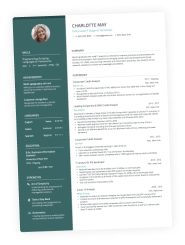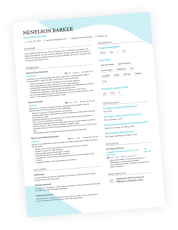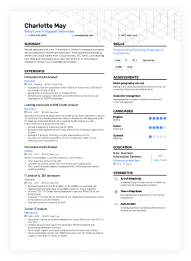Imagine this scenario.
A hiring manager walks into their office to find a towering pile of CVs on their desk. There could be tens, perhaps even hundreds, all vying for the same position.
With just an hour or two to sift through them, the manager doesn't have the luxury of time. Every CV must make an immediate impact.
The first CV is a formatting disaster. Into the bin it goes.
The second CV drones on for six pages. That too is discarded.
But the third CV? It stands out. Its clear structure and compelling heading draw the manager in, prompting them to read further.
Do you see the pattern? The elements that captivated the hiring manager were the clear structure and the engaging heading.
Many people don’t put enough effort into crafting a good heading for their CV… and that’s why they don’t get invited to interviews.
Don’t be one of those people.
In this article we’ll show you:
- What information your CV heading should have
- The things you definitely shouldn’t add to your CV heading
- Some great CV heading examples
Understanding the purpose of your CV heading
Positioned at the very top of your CV, the heading is the first thing recruiters encounter when perusing your application.
Typically, the CV heading encompasses:
- Your full name
- Your contact details, including phone number and email address
- A link to your LinkedIn profile or personal portfolio
- Your current job title or position
It's crucial to note that the style and content of your heading should, to some extent, reflect the industry and role you're targeting.
For example, if you're venturing into the startup world, there's room to describe your current role in a more dynamic and vibrant manner.
But, if you’re applying for roles in more conservative sectors like finance or law, it's advisable to stick to a traditional CV heading.
Looking for a free CV template that fits every industry and position?
We’ll look at several examples of how this could be done in the next section.
Tips for Crafting an Effective CV Heading
By now, you should know that the crucial bits of the CV heading are name, contact information, link, and title.
Let’s look at each of these in more detail.
Adding your name to your CV heading
First and foremost, make sure there are no spelling mistakes in your name.
You’d be surprised at how many CVs get tossed in the bin because of wrong name spelling.
Why? Well, because this shows a lack of focus and detail orientation.
If you prefer, you could add your alias in brackets after your name. This would be especially valid for people who consider their names difficult to pronounce. For instance:
Contact Information in your CV heading
Like it or not, the email address as well as the link you put in your CV can affect the hiring decision greatly.
Would you hire this person:
Their email address and LinkedIn username just don’t match the level of accountability a manager is required to have.
Yet they’re currently a total search manager and we could assume that they’re applying for nothing less than that.
So make sure to always portray yourself in the best light possible - by choosing email addresses and usernames that sound professional. Take this example:
Title in your CV heading
There are two types of titles you can choose from.
The conventional approach is to simply mention your current role or field of expertise. For example:
For instance:
This option would suit any occasion. It doesn’t matter what company you’re applying for. And it also doesn’t matter how much experience you have.
But if you’re applying for a job in a creative industry (or maybe even a startup), you could adopt a different approach.
Namely - the creative title. There are three recipes for it:
- Merge your current position with your passion.
- Combine your current position with "seeking a position in…".
- Simply let your creativity take the lead!
Let’s look at what each of these would look like on your resume!
The “current position + passion” CV title model
This SEO executive immediately stands out as a top candidate for one sole reason - the fact that they’re not only passionate about the field they’re currently working in but rather want to explore the wider industry.
The “current position + “looking for a job in…” CV title model
Adding the field you’d like to grow in next to your current position works miracles for career changers.
Building a job-winning CV for career changes: all you need to know
PRO TIP
If you’re looking for a career change, build your whole CV around this
The ‘let your creativity flow’ CV title model
This one’s for all brave souls out there!
This graphic designer chose to stand out by adding their top skill to their CV heading. Also noting they’re a wizard!
Choosing this approach would work exceptionally well if the hiring manager is looking for someone with strong Photoshop skills who’s also bold and creative.
PRO TIP
Check the job advert to see what skills are highly valued by the hiring manager and highlight these in your CV
Photo in your CV heading
The debate of whether or not you should add a photo to your CV has been around for a while.
And the only answer relevant to the UK job market is simple: NO.
Due to anti-discriminatory laws, adding a photo to your CV is considered bad practice and should definitely be avoided.
This makes things quite simple for applicants - there’s no need to look for the perfect lighting in order to take a professionally looking photo in your living room.
Plus, it saves time that could be used to perfect other aspects of your CV.
Perfecting your CV heading: Key takeaways
Many people ignore the power of the CV heading.
They think its only meaning is for recruiters to get in touch with you.
As you should now recognise, this is a misjudgment.
The CV heading can make or break your application. The most important things to keep in mind would be:
- Ensure there are no spelling mistakes in your name/email address
- Use a formal email address - name.surname@email.com is the most common format for a reason
- Pay proper attention to your title - it could be traditional or more creative depending on your position and the industry
You’ve crafted the ideal CV heading but are still wondering how to approach the rest of your CV? Check out our complete guide on how to write a CV that gets you hired.



